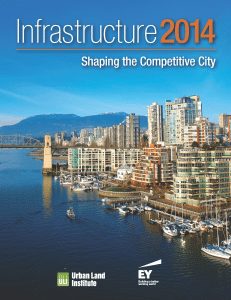A new report from the Urban Land Institute and EY says that telecommunications infrastructure is one of the top factors that influence decisions on real estate investment and development around the world.
The Infrastructure 2014 report was released this week at ULI’s spring meeting and is based on a survey conducted in January 2014 of more than 400 public sector officials and senior-level real estate executives.
Most of those surveyed, about 86%, were based in the U.S., with the rest coming from large and mid-sized cities around the world.
The report concludes that “the quality of infrastructure systems – including transportation, utilities, and telecommunications – is a top factor influencing real estate investment and development decisions in cities around the world.”
Nearly 90% of the participants rated infrastructure quality as the top influence for real estate investment and development. As a group, 91% of the 241 public officials ranked infrastructure as the top factor, with 202 private industry leaders giving infrastructure quality the second-highest influence, slightly behind consumer demand.
When asked about the most important drivers of real estate development and investment, the survey respondents ranked telecommunications infrastructure as the most important driver. A full 75% of overall participants ranked strong telecom systems and connectivity, including high-speed Internet capability, as “a top consideration” or “very important”, with public officials more likely to take that position (78%) than private leaders (71%).
Survey respondents generally ranked their local telecom assets as good or very good: 82% of them praised the available infrastructure, with public officials slightly more likely to give high marks than the private sector (84% vs. 78%). That satisfaction was also reflected in the priority they gave telecom when asked about the priority level that different investments should be given in the next 10 years. Improved telecom infrastructure was only fourth on the list, ranked behind better public transit, roads and bridges, and pedestrian infrastructure.
Read the full report here.

